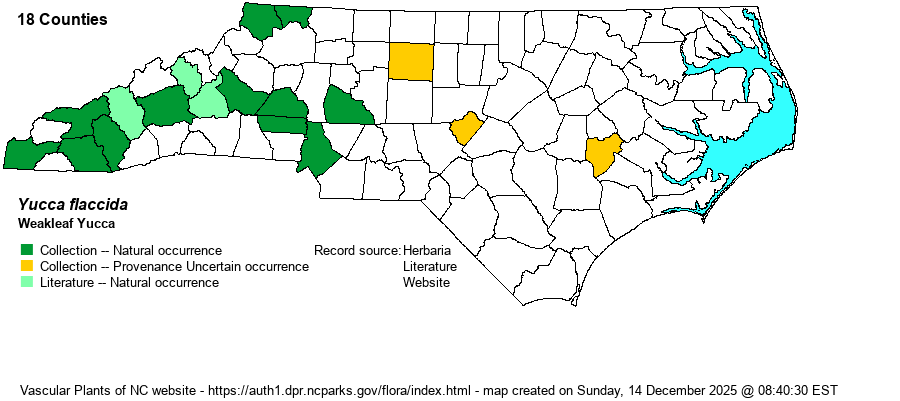| Section 5 » Order Liliales » Family Agavaceae |
Show/Hide Synonym
| taxonName | relationship | relatedTaxonName | relatedTaxonRefText | relComments |
|---|
|
|
|
| Yucca flaccida | = | Yucca filamentosa var. smalliana | Radford, Ahles, and Bell (1968) | | | Yucca flaccida | < | Yucca filamentosa | Gleason and Cronquist (1991) | | | Yucca flaccida | < | Yucca filamentosa | Gleason (1952) | | | Yucca flaccida | < | Yucca filamentosa | Kartesz (1999) | | | Yucca flaccida | < | Yucca filamentosa | Wunderlin & Hansen Flora of Florida (3) | | | Yucca flaccida | = | Yucca smalliana | Fernald (1950) | | | Yucca flaccida | = | Yucca smalliana | Flora of West Virginia | | | Yucca flaccida | < | Yucca flaccida | Flora of North America (1993b, 1997, 2000, 2002a, 2002b, 2003a, 2004b, 2005, 2006a, 2006b, 2006c, 2007a, 2009, 2010) | | | Yucca flaccida | < | Yucca flaccida | | | | Yucca flaccida | > | Yucca flaccida var. flaccida | Ward (2006a). | | | Yucca flaccida | > | Yucca flaccida var. smalliana | Ward (2006a). | | | Source: Weakley's Flora |
|
| Author | Haworth | |
| Distribution | Primarily in the southwestern Piedmont, and to a lesser extent the southern Mountains. A few records farther east in the Piedmont and Coastal Plain and from the northern Mountains, but these might be of non-natural populations. As this is a recent split from Y. filamentosa, it is likely that the species is under-collected/reported. Weakley (2024)'s map now shows that the species is likely native in NC, western VA, and TN, though records from the NC Coastal Plain are not natural.
Poorly known, especially for the native range. Apparently from NC to northern FL, and west to TN and LA. Much is to be learned about this taxon and its natural distribution.
| |
| Abundance | Apparently rare to uncommon in the southwestern Piedmont and the southern Mountains, and rare farther north in the Mountains and into the central Piedmont. It is considered as an NC Watch List species. With collection records from at least a dozen counties within the presumed native range, scattered across much of the western half of the state, the State Rank has been moved from S1 to now S1S2; much is still to be learned about its rarity in the state. | |
| Habitat | This is a taxon of dry and somewhat open woodlands, as is Y. filamentosa. It occurs around granitic flatrocks and perhaps domes, and in other types of partly sunny sites. More information is needed on whether habitats differ from those of the much more common Y. filamentosa. |
| Phenology | Probably blooms mostly from late April into July, and fruits in September and October. | |
| Identification | This is a yucca that is quite similar to Y. filamentosa, being a basal rosette of long and quite slender evergreen leaves to 1.5-2 feet long. However, the leaves are mostly around 1 inch wide, narrower than on Common Yucca, and they are considerably more pliable than the relatively stiff leaves of Common Yucca. The other main distinction is that Weakleaf Yucca has rough, strongly pubescent branches in the inflorescence, as opposed to smooth/glabrous branches in the inflorescence in the common species. As mentioned above, this is a poorly known taxon in NC and other Southeastern states, perhaps not really rare at least in the southwestern Piedmont; closer scrutiny and collections of yuccas (at least the leaves) in the Piedmont and mountains is warranted to further document its range and abundance, plus whether it might be native in the state. | |
| Taxonomic Comments | This is a fairly recent, and still controversial, split. Weakley (2024) expresses some question about whether this is a good species. It was formerly considered as a variety – Y. filamentosa var. smalliana – of the widespread Common Yucca. NatureServe does not list a “Q” on the Global Rank and thus considers this as a good species.
| |
| Other Common Name(s) | None specifically for this taxon, but the usual Adam’s-needle, Spoonleaf Yucca, etc., for the combined two species. | |
| State Rank | S1S2 | |
| Global Rank | G5 | |
| State Status | W7 | |
| US Status | | |
| USACE-agcp | | |
| USACE-emp | | |

